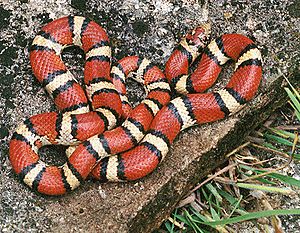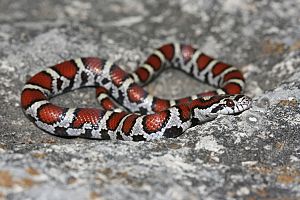Red milk snake facts for kids
Quick facts for kids Red milk snake |
|
|---|---|
 |
|
| An adult red milk snake | |
| Scientific classification |
|
| Kingdom: | Animalia |
| Phylum: | Chordata |
| Class: | Reptilia |
| Order: | Squamata |
| Suborder: | Serpentes |
| Family: | Colubridae |
| Genus: | Lampropeltis |
| Species: | |
| Subspecies: |
L. t. syspila
|
| Trinomial name | |
| Lampropeltis triangulum syspila Cope, 1889
|
|

The red milk snake, also known as Lampropeltis triangulum syspila, is a type of snake. It's a special kind of milk snake. This snake is not venomous, meaning it's not poisonous. It belongs to a group of snakes called colubrids, which are common snakes found all over the world. You can find the red milk snake living naturally in the central parts of the United States.
Contents
Where Do Red Milk Snakes Live?
Red milk snakes live in many states across the central United States. You can find them from southern Indiana all the way to northwestern Mississippi. They also live in western Kentucky and southeastern South Dakota. Their home range extends through eastern Oklahoma and Kansas. There's even a small group of these snakes living separately in the William B. Bankhead National Forest in northwestern Alabama.
What Does a Red Milk Snake Look Like?
Red milk snakes are usually about 60 to 91 centimeters (24 to 36 inches) long. That's about the length of a baseball bat! Some have been measured to be even longer, up to 132 centimeters (52 inches). Their scales are very smooth and shiny.
Colors and Patterns
These snakes have a cool pattern on their backs. They have narrow bands of white, light gray, cream, or tan colors. These lighter bands are outlined in black. Between these bands are bright red patches, called saddles. Sometimes, these red patches can be reddish-brown or even grayish-brown.
Their bellies are usually white with a checkered pattern in black. The head of a red milk snake often has a large red spot. This red spot is also outlined in black, making it stand out.
What Do Red Milk Snakes Eat?
Red milk snakes are constrictors. This means they wrap around their prey and squeeze it until it can't breathe. They eat a variety of small animals. Their diet includes small rodents like mice. They also eat other reptiles, such as lizards and other snakes. Sometimes, they will eat amphibians like frogs, and even small birds.
Images for kids



